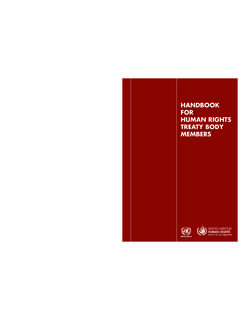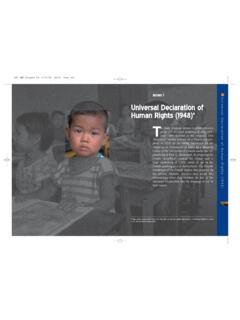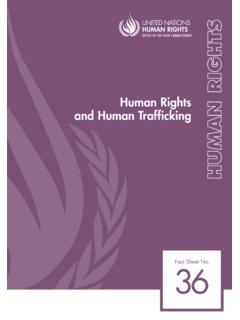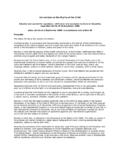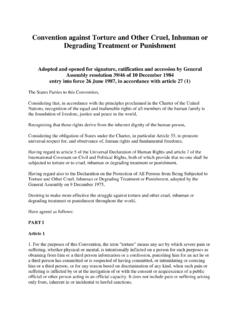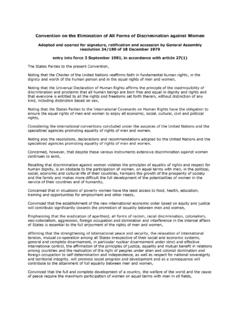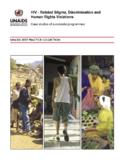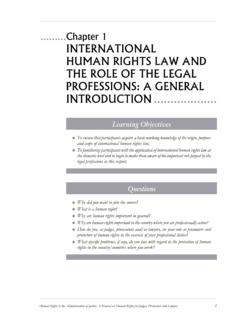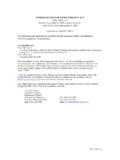Transcription of FREQUENTLY ASKED QUESTIONS ON A HUMAN RIGHTS …
1 OFFICE OF THE UNITED NATIONSOFFICE OF THE UNITED NATIONSHIGH COMMISSIONER HIGH COMMISSIONER FOR HUMAN RIGHTSFOR HUMAN RIGHTSFREQUENTLY ASKED QUESTIONSON A HUMAN RIGHTS -BASED APPROACH TO DEVELOPMENT COOPERATIONUNITED NATIONSNew York and Geneva, 2006 OFFICE OF THE UNITED NATIONSHIGH COMMISSIONERFOR HUMAN RIGHTSFREQUENTLY ASKED QUESTIONSON A HUMAN RIGHTS -BASEDAPPROACH TO DEVELOPMENTCOOPERATIONUNITED NATIONSNOTEThe designations employed and the presentation of the material in this publication do not imply the expression of any opinion whatsoever on the part of the Secretariat of the United Nations concerning the legal status of any country, territory, city or area, or of its authorities.
2 Or concerning the delimitation of its frontiers or boundaries.** *Material contained in this publication may be freely quoted or reprinted, provided credit is given and a copy of the publication containing the reprinted material is sent to the Office of the United Nations High Commissioner for HUMAN RIGHTS , Palais des Nations, 8-14 avenue de la Paix, CH-1211 Geneva 10, creditsCover page: International Labour Organization/M. Crozet; United Isaac; Enrico Bartolucci/Still Pictures; UNESCO/Maria Muinos; p. 4: Hartmut Schwarzbach/Still Pictures; p.
3 5: UN Photo/Eskinder Debebe; p. 7: UNESCO/Maria Muinos; p. 9: International Labour Organization/J. Maillard; p. 11: Argus/Still Pictures; Enrico Bartolucci/Still Pictures; p. 13: Otto Stadler/Still Pictures; p. 16: UN Photo/Evan Schneider; p. 17: Ron Giling/Still Pictures; UN Photo/Sebastiao Barbosa; p. 19: Friedrich Stark/Still Pictures; p. 20: UNESCO/Alexis N. Vorontzoff; p. 24: International Labour Organization/J. Maillard; p. 26: Ron Giling/Still Pictures; Manfred Vollmer/Still Pictures; p. 30: United Nations/IYV; p.
4 31: United Nations/DPI/Eskinder the dawn of the new millennium, HUMAN RIGHTS and development are at a crossroads. On the one hand, the congruence between HUMAN RIGHTS and development the-ory has never been more striking. Poverty and inequities between and within countries are now the gravest HUMAN RIGHTS concerns that we face. As the Secretary-General un-derscored in his 2005 reform report In larger freedom , the challenges of HUMAN RIGHTS , development and security are so closely entwined that none can be tackled effec-tively in Nations agencies have gone a considerable way towards reflecting these realities in practice, including through defining a common understanding of a HUMAN RIGHTS -based approach to development cooperation.
5 Em-bodied within the United Nations common programming guidelines. And at the World Summit in September 2005, United Nations Member States gave an unprecedented po-litical imprimatur and impetus to the Organization s efforts to bring HUMAN RIGHTS to the front and centre of all its work, a shared commitment that through my 2005 Plan of ac-tion I am determined to there remains a chasm between theory and practice, ensuring that the objectives, policies and processes of development are channelled more directly and effectively towards HUMAN RIGHTS goals.
6 There are, of course, many reasons why this is so, including continuing gaps in knowl-edge and skills, and difficulties in translating HUMAN RIGHTS norms into concrete programming guidance applicable in diverse policy contexts and national circumstances. This is the principal gap that this publication aims to fill, with United Nations development practitioners as the primary collective and multifaceted effort is required of HUMAN RIGHTS and development practitioners, now more so than ever.
7 Filling gaps in knowledge, skills and capacities will be meaningless without renewed leadership, commitment and attention to our own internal accountability systems and incentive structures. The valuable contributions brought to this publication from our United Nations development part-ners are testimony to the kind of collaboration that should be further a modest contribution on its own, I hope that this publication will succeed in advancing our shared under-standing about how the goals of HUMAN RIGHTS and devel-opment can be achieved through more effective develop-ment cooperation.
8 Within wider strategies and coalitions for ArbourUnited Nations High Commissioner for HUMAN RightsFOREWORDIIIACKNOWLEDGEMENTSE arlier drafts of this publication were shaped greatly from inputs from partner agencies in the United Nations system. The Office of the United Nations High Commissioner for HUMAN RIGHTS (OHCHR) wishes to express particular thanks to the following, although final responsibility rests of course with OHCHR: Carmen Artigas (Chief, HUMAN RIGHTS Unit, Economic Commission for Latin America and the Caribbean), Marc Derveeuw (United Nations Population Fund Country Support Team, Harare), Emilie Filmer-Wilson (Oslo Governance Centre, United Nations Development Programme (UNDP)), Sascha Graumann (Deputy Chief, UNDP SURF Bratislava), Nadia Hijab (consultant to joint OHCHR/UNDP HURIST programme, New York)
9 , Zanofer Ismalebbe ( HUMAN RIGHTS Focal Point and HURIST programme officer, UNDP Geneva), Marcia Kran (Democratic Governance Practice Manager, UNDP SURF Bratislava), Carole Landon (Department of Country Focus, World Health Organization (WHO) Geneva), Else Leona McClimans (Oslo Governance Centre, UNDP), Helena Nygren-Krugh (Health and HUMAN RIGHTS Adviser, WHO Geneva), Thord Palmlund (consultant to joint OHCHR/UNDP HURIST programme, New York), Barbara Pesce-Monteiro (Director, UNDP Guatemala), Patrick van Weerelt ( HUMAN RIGHTS Adviser, UNDP New York), Lee Waldorf ( HUMAN RIGHTS Adviser, United Nations Development Fund for Women) and Richard Young (United Nations Children s Fund (UNICEF) Representative, Kyrgyzstan).
10 The drafting suggestions and sustained contributions from Urban Jonsson (UNICEF), Detlef Palm (Chair, Global QSA Group for CCA/UNDAF, UNICEF New York), Fabio Sabatini (Regional Programme Officer, UNICEF Geneva), Christian Salazar-Volkmann (UNICEF Representative, Islamic Republic of Iran) and Joachim Theis (Youth and Partnerships Officer, UNICEF Regional Office, Bangkok) deserve special RIGHTS1. What are HUMAN RIGHTS ?..12. Is there any hierarchy among HUMAN RIGHTS ?..23. What kinds of HUMAN RIGHTS obligations are there?

